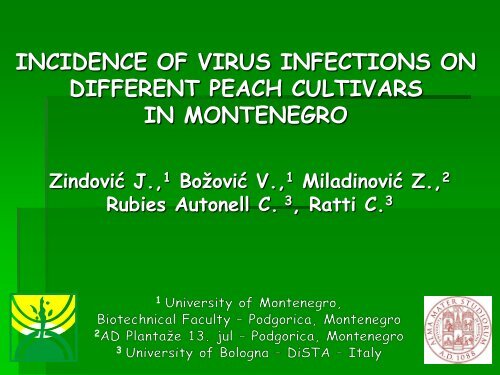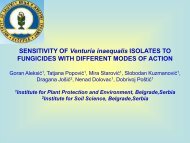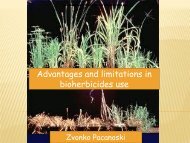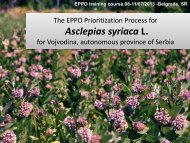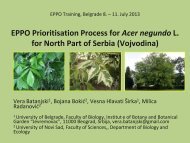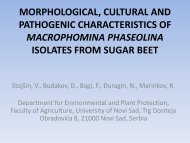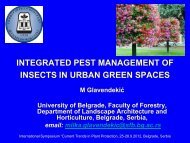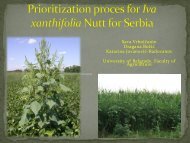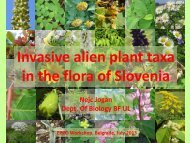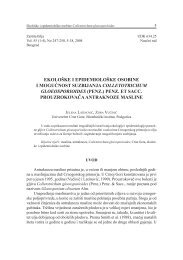INCIDENCE OF VIRUS INFECTIONS ON DIFFERENT PEACH CULTIVARS IN MONTENEGRO
incidence of virus infections on different peach cultivars in ... - Izbis
incidence of virus infections on different peach cultivars in ... - Izbis
- No tags were found...
Create successful ePaper yourself
Turn your PDF publications into a flip-book with our unique Google optimized e-Paper software.
<strong><strong>IN</strong>CIDENCE</strong> <strong>OF</strong> <strong>VIRUS</strong> <strong><strong>IN</strong>FECTI<strong>ON</strong>S</strong> <strong>ON</strong><br />
<strong>DIFFERENT</strong> <strong>PEACH</strong> <strong>CULTIVARS</strong><br />
<strong>IN</strong> M<strong>ON</strong>TENEGRO<br />
Zindović J., 1 Božović V., 1 Miladinović Z., 2<br />
Rubies Autonell C. 3 , Ratti C. 3<br />
1<br />
2<br />
3
Peach production in Montenegro<br />
Stone fruit<br />
production<br />
Total surface (ha)<br />
Enterprises and<br />
collective farms<br />
Private farms<br />
Plum ca. 1210 ha ca. 5 ha ca. 1205 ha<br />
Peach ca. 185 ha ca. 85 ha ca. 100 ha<br />
Cherries ca. 125 ha ca. 3 ha ca. 122 ha<br />
Peach ranking second in planted surface in stone<br />
fruit production in MNE<br />
Podgorica’s region is the main peach-growing area<br />
45% of peach production posses enterprises (AD<br />
Plantaze 13. jul)<br />
AD Plantaze 13. jul (locality Ćemovsko field): 85 ha<br />
with 19 different cultivars
Investigation on peach viruses<br />
Previous surveys<br />
This survey<br />
Presence of PPV on plum<br />
(PPV-D and PPV-Rec) and<br />
peach (PPV-M) was<br />
confirmed in 2007<br />
Zindovic et al., 2008<br />
Viršček-Marn et al., 2008<br />
PPV was confirmed in 17<br />
out of 18 tested samples<br />
Presence of PLMVd was<br />
confirmed in 2011<br />
Mavrič-Pleško et al. 2011<br />
Survey is conducted in<br />
Podgorica region<br />
(ca. 80 ha)<br />
Locality:<br />
Ćemovsko field<br />
9 peach cultivars were<br />
examined for the<br />
presence of 9 peach<br />
viruses
Aim of investigation<br />
• Presence of different economically important<br />
peach viruses in Montenegro<br />
• Incidence of 9 peach viruses in different peach<br />
cultivars<br />
• Molecular characterization of the most<br />
prevalent peach virus<br />
• Molecular variability of selected PPV isolates<br />
• Reconstruction of phylogenetic trees based on<br />
sequences of investigated virus isolates
Examined cultivars and viruses<br />
Cultivars (out of 19):<br />
Adriana<br />
Caldesi<br />
Gloria<br />
Maria Marta<br />
May Crest<br />
Morsiani<br />
Rita Star<br />
Spring Belle<br />
Spring Crest<br />
Viruses (9):<br />
Plum pox virus (PPV)<br />
Prunus necrotic ringspot virus<br />
(PNRSV)<br />
Prune dwarf virus (PDV)<br />
Apple chlorotic leaf spot virus<br />
(ACLSV)<br />
Peach mosaic virus (PMV)<br />
Cherry mottle leaf virus (CMLV)<br />
Strawberry latent ringspot virus<br />
(SLRSV)<br />
Tobacco ringspot virus (TRSV)<br />
Tomato ringspot virus (ToRSV)
Field survey<br />
In September and<br />
October 2011, 58<br />
symptomatic leaves<br />
samples were collected<br />
Symtoms: chlorotic<br />
ringspots, veinal chlorosis,<br />
netting, leaf distortion,<br />
stunting, rosette<br />
formation blotches and<br />
deformations
Field survey<br />
cv. Ritastar<br />
cv. Ritastar<br />
Symptoms on Prunus persica indicative of PNRSV infection:<br />
hlorotic rings and spots, mosaic
cv. Ritastar 370/11 cv. Ritastar 372/11<br />
Symptoms on Prunus persica indicative of PPV infections:<br />
vein chlorosis and netting
Molecular methods used for the detection of stone fruit viruses<br />
Virus Primers Primers sequences (5’ - 3’)<br />
ACLSV<br />
CMLV<br />
PMV<br />
PNRSV<br />
PDV<br />
PPV<br />
TRSV<br />
ToRSV<br />
SLRSV<br />
ACLSRV F<br />
ACLSV R<br />
PM16AFF<br />
PM16AFR<br />
PM16AFF<br />
CML-26R<br />
Ilar 2F<br />
Ilar 1R<br />
PDV 2F<br />
PDV 1R<br />
PPV 8511-8532 F<br />
PPV 9763-9784 R<br />
P241<br />
P316D<br />
P316M<br />
PPV-DM probe<br />
TRSVf1<br />
TRSVr1<br />
ToRSVf1<br />
ToRSVr1<br />
3DR<br />
F1<br />
2R2<br />
5DF<br />
GGCAACCCTGGAACAGA<br />
CAGACCCTTATTGAAGTCGAA<br />
CAAACATGGCTTTCACCTTCTGCA<br />
TCTTGCCCCACCCTTCAACAAATG<br />
CAAACATGGCTTTCACCTTCTGCA<br />
AGATCCTCTTTCCCTTCTAAAATG<br />
CCACCGAGAGGTTGGCA<br />
TTCTAGCAGGTCTTCATCGA<br />
ATGGATGGGATGGATAAAATAGT<br />
TAGTGCAGGTTAACCAAAAGGAT<br />
CGATATCTTGAAGCTTTTTACG<br />
CTCTTGCACAAGAACTATAACC<br />
CGTTTATTTGGCTTGGATGGAA<br />
GATTAACATCACCAGCGGTGTG<br />
GATTCACGTCACCAGCGGTGTG<br />
FAM-CGTCGGAACACAAGAAGAGGACACAGA-<br />
TAMRA<br />
GGAAGCTGTATAAACTCAGC<br />
GTGTTGGACAAACACGACAC<br />
GGAAGCTGTATAAACTCAGC<br />
GTCCTCATGGAACCTTTCTC<br />
AGGCTCAAGAAAACACAC<br />
GGCTGATCCTCGTGAGAC<br />
GCGTGTGGCGTCGCTAAT<br />
CCCTTGGTTACTTTTACCTCCT<br />
Size of<br />
amplicon<br />
358 bp<br />
Reference<br />
Nemichov et<br />
al., 1995<br />
Method<br />
RT-PCR<br />
419 bp<br />
Delano and<br />
RT-PCR<br />
705 bp<br />
Upton, 1999<br />
RT-PCR<br />
206 bp<br />
173 bp<br />
Candresse<br />
et al., 1997<br />
Parakh et al.,<br />
1995<br />
RT-PCR<br />
RT-PCR<br />
1274 bp This work RT-PCR<br />
243 bp<br />
Olmos et al.,<br />
2005<br />
Real Time PCR<br />
338 bp<br />
Martin et al.,<br />
RT-PCR<br />
512 bp<br />
2009<br />
RT-PCR<br />
739 bp<br />
RT-PCR<br />
203 bp<br />
Ratti et al.,<br />
2008 Nested PCR
Incidence of different stone fruit’s viruses in<br />
Montenegrin peach<br />
70.7% of samples were infected by at least one of<br />
ascertained viruses<br />
Single and double infections were confirmed, respectively,<br />
in 56.9% and 13.8% of the assayed plants<br />
Incidence of single and double infections<br />
not infected<br />
29.3%<br />
duble infections<br />
13.8%<br />
single infections<br />
56.9%<br />
Molecular analysis revealed:<br />
Presence of PPV, PNRSV and<br />
PDV<br />
Double infection were found<br />
between PPV+PNRSV and<br />
PPV+PDV<br />
Absence of ACLSV, PMV,<br />
CMLV, SLRSV, TRSV and<br />
ToRSV from all tested samples
Incidence of PPV, PNRSV and PDV in examined<br />
peach cultivars<br />
Cultivar PPV PNRSV PDV<br />
PPV was detected in<br />
60,3% of assayed samples<br />
PNRSV was detected in<br />
18,9% of assayed samples<br />
PDV was detected in<br />
1,7% of assayed samples<br />
Maria Marta<br />
Spring Belle<br />
Spring Crest<br />
Adriana<br />
May Crest<br />
Gloria<br />
Morsiani<br />
Rita Star<br />
Caldesi<br />
83.3% 0% 0%<br />
83.3% 0% 0%<br />
75.0% 25.0% 0%<br />
66.7% 0% 16.7%<br />
66.7% 66.7% 0%<br />
62.5% 0% 0%<br />
62.5% 0% 0%<br />
55.5% 55.5% 0%<br />
0% 0% 0%
Detection of PPV by Real-Time RT-PCR<br />
39 out of 58 samples showed positive results in Real-Time<br />
PCR<br />
8 highly infected PPV isolates (from each infected cultivar)<br />
were chosen for further analysis<br />
Molecular variability is determined using RT-PCR and primers<br />
targeting CP region (1276 bp)<br />
1276 bp<br />
negative<br />
control
Purification of PCR products<br />
Cloning in pGEM-T Easy vector<br />
• 8 PPV isolates were<br />
purified, cloned and<br />
sequenced<br />
• Screening of colonies was<br />
performed by PCR using<br />
M13-for/M13-rev primers<br />
Purification of plasmid-DNA<br />
~1500 bp<br />
Sequencing<br />
Screening of colonies
Molecular characterization<br />
• Nucleotide sequences of complete CP gene derived from<br />
Montenegrin isolates were compared with previously described<br />
PPV sequences deposited in GenBank (92,2 – 99,1%)<br />
• BLAST analysis showed:<br />
• MNE isolates from Gloria, May Crest, Adriana and Rita Star<br />
were the most closely related (97,1 – 99,1%) with isolate<br />
SK68 (M92280.1)<br />
• MNE isolates from Morsiani, Maria Marta and Spring Crest<br />
shared most identity (97,6 – 98,4%) with previously reported<br />
Montenegrin isolate Godinje 1 (HQ452396) from region of Bar<br />
• MNE isolate from cv. Spring Belle was most similar with<br />
sequence of Greek isolate N1 (FJ361234) from peach.
Phylogenetic analysis<br />
• Phylogenetic tree was constructed using<br />
Neighborn-Joining method with bootstrap analyses<br />
of 1000 replicates within MEGA 4.1 software<br />
(Tamura et al., 2007)<br />
• Phylogenetic tree was generated from complete<br />
nucleotide sequence of CP gene of 44 PPV isolates:<br />
8 from this study<br />
36 from NCBI database
• To date 7 PPV strains were<br />
defined (PPV-D, PPV-M,<br />
PPV-Rec, PPV-EA, PPV-W,<br />
PPV-T and PPV-C)<br />
• All isolates clustered within<br />
5 strain groups (PPV-D,<br />
PPV-M, PPV-Rec, PPV-T<br />
and PPV-C)<br />
• Phylogenetic analysis using<br />
sequences of complete CP<br />
gene showed that all<br />
Montenegrin isolates from<br />
peach belong to PPV-M<br />
strain
Molecular analysis for PNRSV<br />
• Detection of PNRSV by RT-<br />
PCR using Ilar2F/Ilar1R<br />
primers<br />
206 bp<br />
• 11 out of 58 assayed peach<br />
samples were positive on<br />
PNRSV<br />
• PNRSV was confirmed in 3<br />
cultivars: Rita Star, May<br />
Crest and Spring Crest<br />
• Highest infection rate<br />
(66,7%) was confirmed in<br />
cv. May Crest<br />
RT-PCR using Ilar2F/Ilar 1R primers
Molecular characterization<br />
• 4 PNRSV isolates derived<br />
from cv.s Rita Star (2),<br />
May Crest (1) and Spring<br />
Crest (1) were chosen for<br />
further analysis<br />
• Complete CP gene was<br />
amplified by RT-PCR using<br />
MG1/MG2 primers (Glasa et<br />
al., 2008)<br />
• Isolates were cloned and<br />
sequenced<br />
Screening of PNRSV isolates<br />
by PCR using M13-for/M13-rev
• Sequence analyses of CP gene from PNRSV<br />
isolates proved to be 89.3 – 100% identical with<br />
corresponding sequences of isolates previously<br />
described<br />
• 2 PNRSV isolates from cv. Rita Star were most<br />
closely related to Chilean NctCl.augl isolate from<br />
nectarine (EF565253)<br />
• PNRSV isolates from cv.s May Crest and Spring<br />
Crest were most closely related to Italian isolate<br />
PchIt.may1 from peach cv. May Crest
• Sequences of 4 PNRSV<br />
isolates were deposited<br />
in GenBank (JX569825<br />
- JX569828)<br />
• Isolates clustered<br />
within three groups:<br />
PE-5, PV-32 and PV-<br />
96<br />
• 2 MNE isolates from<br />
cv. Rita Star clustered<br />
in PE-5 group<br />
• Isolates from cv. May<br />
Crest and Spring Crest<br />
clustered in PV-96<br />
Phylogenetic tree was constructed<br />
using minimum-evolution method with Tamura-Nei<br />
corrected nt distance and bootstrap analyses of<br />
10000 replicates within MEGA 4.1 software
Molecular analysis for PDV<br />
• RT-PCR method using PDV-2F/PDV-1R primers (173 bp)<br />
• Presence of PDV was confirmed in only 1 out of 58<br />
samples<br />
• BLAST analysis revealed high similarity,<br />
ranging from 94.2 to 96%,<br />
with isolates reported<br />
from other parts of the world<br />
• Highest value MNE isolates<br />
showed with Ch 137 isolate<br />
(L28145)<br />
173 bp<br />
RT-PCR for PDV (CP)
Conclusions<br />
• RT-PCR were used to identify infection by PPV, PDV, PNRSV,<br />
ACLSV, PMV, CMLV, TRSV, ToRSV and SLRSV in stone<br />
fruits. Nested-PCR (n-PCR) method was also used to detect<br />
SLRSV and Real-time RT-PCR to detect PPV<br />
• The study reported presence of one quarantine virus (PPV) and<br />
two “quality” viruses (PDV and PNRSV)<br />
• The study reported very high incidence of PPV (60.3%).<br />
PNRSV was detected in 18.9% and PDV in 1.7% assayed<br />
samples<br />
• All other assayed peach viruses were not detected in the<br />
collected samples
• Real Time RT-PCR identified more PPV infected samples<br />
than RT-PCR indicating higher sensitivity<br />
• Amplification of different amplicons from the detected<br />
viruses by RT-PCR, followed by cloning of complete and<br />
partial sequences of CP gene allowed phylogenetic<br />
analysis of isolates of different detected viruses: PPV<br />
(8), PNRSV (4) and PDV (1)<br />
• Sequence analyses revealed that all Montenegrin PPV<br />
isolates shared from 92.2 to 99.1% nucleotide identity<br />
with corresponding PPV-M strain sequences deposited in<br />
GenBank
• Results indicate the most probable introduction of PPV<br />
in Montenegro through peach propagation material<br />
which is mainly imported from Greece where this strain<br />
is the most prevailing one<br />
• Phylogenetic analysis suggesting two possible<br />
introductions of PNRSV in Montenegro<br />
• Molecular grouping of PNRSV isolates wasn’t in<br />
correlation with geographical region and host<br />
• Urgent sanitation measures should be taken:<br />
eradication of infected trees<br />
severe control related to importation of plant material
Thank you for your attention!!!


